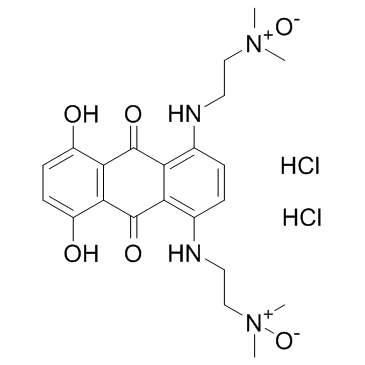Banoxantrone dihydrochloride
Modify Date: 2025-08-25 21:59:28

Banoxantrone dihydrochloride structure
|
Common Name | Banoxantrone dihydrochloride | ||
|---|---|---|---|---|
| CAS Number | 252979-56-9 | Molecular Weight | 517.40300 | |
| Density | N/A | Boiling Point | N/A | |
| Molecular Formula | C22H30Cl2N4O6 | Melting Point | N/A | |
| MSDS | N/A | Flash Point | N/A | |
Use of Banoxantrone dihydrochlorideBanoxantrone dihydrochloride is a novel bioreductive agent that can be reduced to a stable, DNA-affinic compound AQ4, which is a potent topoisomerase II inhibitor. |
| Name | 2-[[4-[2-[dimethyl(oxido)azaniumyl]ethylamino]-5,8-dihydroxy-9,10-dioxoanthracen-1-yl]amino]-N,N-dimethylethanamine oxide,dihydrochloride |
|---|---|
| Synonym | More Synonyms |
| Description | Banoxantrone dihydrochloride is a novel bioreductive agent that can be reduced to a stable, DNA-affinic compound AQ4, which is a potent topoisomerase II inhibitor. |
|---|---|
| Related Catalog | |
| Target |
Topoisomerase II |
| In Vitro | Banoxantrone (AQ4N) can be reduced in a hypoxic environment to a stable DNA-affinic agent AQ4. AQ4, a potent topoisomerase II inhibitor, would be capable of damaging cells recruited into the cell cycle following radiation damage to the well-oxygenated cells of the tumor[1]. Banoxantrone shows more than 8-fold higher cytotoxicity under hypoxia than normoxia in cultures of 9L rat gliosarcoma and H460 human non-small-cell lung carcinoma cells but not for 11 other human cancer cell lines. DT-diaphorase protein levels and banoxantrone chemosensitivity are poorly correlated across the cancer cell line panel, and banoxantrone chemosensitivity is not affected by DT-diaphorase inhibitors[2]. Banoxantrone is a bis-N-oxide that is reduced via two sequential two-electron reductions to the tertiary amine, AQ4, which is a potent cytotoxic agent toward both aerobic and hypoxic cells. AQ4, but not AQ4N, intercalates in DNA with high affinity to generate a stable persistent complex that can inhibit topoisomerase II and cause DNA damage and cell death[3]. |
| In Vivo | Banoxantrone (200 mg/kg) significantly enhances the tumor growth delay caused by radiation. This occurred when radiation is administered both as a single dose (12 Gy) and in a multifraction regimen (5x3 Gy). A study of the scheduling of Banoxantrone (AQ4N) administration shows that there is a very long time period over which a maximal effect can be elicited (drug given 4 days before to 6 h after radiation). These results suggest that Banoxantrone has significant potential as a bioreductive drug[1]. The activation of banoxantrone cytotoxicity in vivo requires tumor hypoxia that is more extensive or prolonged than can readily be achieved by vasodilation or by antiangiogenic drug treatment[2]. Incorporation of banoxantrone into conventional chemoradiation protocols therefore targets both oxygenated and hypoxic regions of tumors, and potentially will increase the effectiveness of therapy. A single dose of 60 mg/kg banoxantrone enhances the response of RT112 (bladder) and Calu-6 (lung) xenografts to treatment with cisplatin and radiation therapy. Banoxantrone will increase the efficacy of chemoradiotherapy in preclinical models[3]. |
| Kinase Assay | Untreated T50/80 tumors (6.5-9.0 mm geometric diameter (GMD) are excised and gently disaggregated by mechanical disruption in ice-cold phosphate-buffered saline (PBS). Single cell suspensions are prepared by filtration through a 40μm mesh. These are then centrifuged and resuspended in Eagle's minimal essential medium (EMEM) containing 10% fetal calf serum (FCS) at a concentration of 106 cells/mL. Cells (20 mL) are placed in 125 mL rubber sealed glass bottles. These are gassed for 2 h at 37°C to provide welloxygenated conditions, i.e. 95% air/5% carbon dioxide or hypoxic conditions 95% N2/5% CO2. Banoxantrone (AQ4N) (20μM) is added for the last 90 min of this period by injection through the sealed lid. Drug is washed off and cells resuspended in fresh medium. For analysis of DNA damage, aliquots (105 cells) are processed at various times ranging from 0 to 96 h after this procedure. To evaluate the effect of maintaining the excised tumor cells in culture, samples are also maintained in the culture medium above at 37°C, 95% air/5% CO2 for 24 h. The cells, which grow in suspension, are then harvested and placed in glass bottles and the experiment outlined above is carried out. Each experiment is carried out twice and the results pooled[1]. |
| Animal Admin | Mice[1] T50/80 tumor-bearing mice are used. These experiments are carried out when tumors reach a geometric diameter (GMD) of 6.5-9.0 mm. Banoxantrone (AQ4N) is administered as a single i.p. injection at a dose of 200 mg/kg. The drug is given 30 min before a single dose of X-irradiation of 12 Gy (300 kVp Siemens Stabilipan with a dose rate of 2.56 Gy min-1). Tumors are excised at a range of times following treatment and placed on ice. Single cell suspensions are prepared in ice-cold PBS as outlined above. Following centrifugation the cells are diluted in cold EMEM containing 10% FCS (1x106 cells/mL). An aliquot of 100 μL of this suspension is used in the comet assay. This procedure is carried out on tumors excised at various time intervals ranging from 0 to 120 h following irradiation. The results are pooled from three individual experiments. |
| References |
| Molecular Formula | C22H30Cl2N4O6 |
|---|---|
| Molecular Weight | 517.40300 |
| Exact Mass | 516.15400 |
| PSA | 157.52000 |
| LogP | 3.63720 |
| InChIKey | SBWCPHUXRZRTDP-UHFFFAOYSA-N |
| SMILES | C[N+](C)([O-])CCNc1ccc(NCC[N+](C)(C)[O-])c2c1C(=O)c1c(O)ccc(O)c1C2=O.Cl.Cl |
| Storage condition | 2-8℃ |
| Banoxantrone dihydrochloride |
| AQ4N |
| 1,4-Bis((2-(dimethylnitroryl)ethyl)amino)-5,8-dihydroxyanthra-9,10-quinone dihydrochloride |
| Banoxantrone (dihydrochloride) |